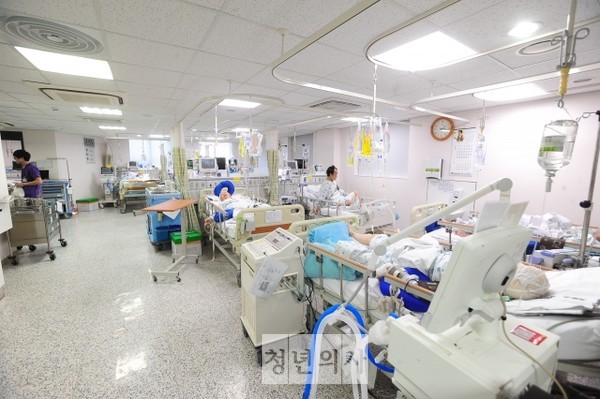Tertiary hospitals in Seoul with 1,500 beds and more should reduce general beds by 15 percent if they participate in the government's pilot project to restructure tertiary hospitals, officials said.
Other tertiary hospitals in Seoul, Incheon, and Gyeonggi Province should reduce general beds by 10 percent and those outside the Seoul metro region by 5 percent.

The government plans to compensate institutions participating in the pilot project with 3 trillion won ($2.24 billion) -- 1.5 trillion won in compensation for intensive care unit hospitalization, 500 billion won for surgeries of severe cases, and 1 trillion won for post-de-facto compensation.
The Ministry of Health and Welfare unveiled the action plans of the pilot project for restructuring tertiary general hospitals at a public hearing on “innovative medical supply and utilization system reorganization plan” hosted by the Special Committee on Healthcare Reform at a hotel in downtown Seoul on Wednesday.
The pilot project aims to transform the structure of five major areas -- medical treatment, medical cooperation, beds, manpower, and the training of junior doctors.
In medical treatment, the pilot project aims to strengthen the treatment of severe and essential cases and expand the number of patients in severe and essential medical areas to more than 60 percent within three years of the pilot project.
Regarding beds, the ministry also disclosed requirements for participating in the pilot project.
More specifically, Seoul-based tertiary general hospitals with 1,500 beds or more must aim to reduce 15 percent of their approved beds, other tertiary general hospitals in Seoul, Gyeonggi Province, and Incheon must reduce 10 percent, and those outside the greater Seoul area by 5 percent, to participate in the pilot project.
The government also plans to raise the share of critical care beds to general beds and link it to performance rewards. The ministry cited Johns Hopkins Hospital in the U.S. as an example, where it said 17 percent of all beds are critical care beds, compared to 10 percent at Korean tertiary general hospitals.
The ministry would consider setting a standard number of specialists per bed to strengthen bed management and curb bed expansion. The ministry also compared Johns Hopkins Hospital, which has 21.7 specialists per 10 beds, to Korea's maximum of 4.8.
The workforce restructuring will focus on expanding skilled manpower and reorganizing existing manpower rather than hiring more specialists. To expand skilled manpower, the ministry plans to switch trainee doctors' on-call duty to a team comprising specialists and support nurses, reducing the treatment load of trainee doctors from the present 40 percent to 20 percent.
3 trillion won in compensation for hospital restructuring pilot project
The government has set aside 3 trillion won for compensation for medical institutions participating in the pilot project. Of this, 1.5 trillion won will be paid for hospitalization in intensive care units, 500 billion won for severe-disease surgeries, and 1 trillion won for post-de-factor compensation. The government will announce a specific plan before entering into the pilot project.
The ministry plans to launch the pilot project in the second half of the year after deliberation by the Health Insurance Policy Review Committee in September.
In the discussion following the presentation, participants presented various opinions regarding restructuring tertiary general hospitals.
Park Jin-sik, director of Sejong Hospital, emphasized that the pilot project should allow tertiary general hospitals to transition without disadvantages and losses, and that it should be a direction that requires cooperation rather than competition among medical institutions.
“The current situation has been caused not because tertiary general hospitals have done something wrong but because they have been thrown into a situation where they have had to stage limitless competition,” Park said. “If unlimited competition continues, the pilot project will produce similar results.”
“Competition between different types of medical institutions in the region should be replaced by cooperation,” Park said. “In that sense, hospitals are expanding the number of severe and specialized diseases for the pilot project, many of which can be treated in regional secondary hospitals. This can encourage competition between hospitals.”
Park also pointed out problems caused by including robotic surgery in the list of suitable diseases for severe patients. “Robotic surgery is a treatment method, not related to the severity of the disease,” he said. “It could result in indiscriminate robotic surgery.”
Professor Lee Sang-il of the Department of Preventive Medicine at the University of Ulsan College of Medicine said, “This is not the first time we are trying to redefine tertiary general hospitals. We have already started a pilot project to strengthen the critical care system, but only three hospitals participated. However, the new pilot project to restructure tertiary hospitals will be an important opportunity (for restructuring) because it cannot be done in the existing way without the participation of hospitals.”
Professor Lee continued, “I agree with the Health and Welfare Ministry's plan as a whole, but the key is to make it work well in the real world because policies do not always work as designed.”
Related articles
- Teaching hospitals fire 7,648 trainee doctors, seek to hire 7,707 in autumn
- ‘Weaning tertiary hospitals off reliance on trainee doctors will raise labor costs by 50%’
- Korean hospitals excel in pediatrics in APAC: Newsweek
- Amid dwindling revenues, university hospitals tighten their belts to stay afloat
- 30,000 unionized medical workers to launch general strike on Thursday

